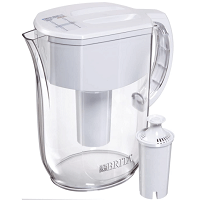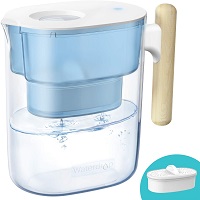Table of Contents [show]
Those of you who own a water filter pitcher probably didn't put much thought into water filtration after your initial pitcher purchase. Perhaps you have invested in a few replacement filter cartridges, or didn't notice enough of a difference to justify the continued use of a water filter pitcher. I mean, the whole idea behind this product design is to fill and go – right?
Have You Changed the Filter Recently?
Chances are you are, at the very least, somewhat familiar with Brita brand water pitchers – a product which enables users to fill at the tap. By utilizing gravity, water trickles through a simple carbon cartridge filter, down to the lower compartment. The biggest issue with this design, however, is the dependency upon regularly renewed carbon water filter cartridges. If you own a Brita filter, how confident are you in your upkeep?
Many individuals put their hope in Brita filters because of their availability, affordability, and overall ease of use. From the get go, users typically notice a marked improvement in flavor by simply filtering their tap water through a Brita water filter pitcher. Aside from better tasting water, does this type of water filter actually purify drinking water? Due to the simplicity of this type of water filter cartridge, you might be surprised to learn about the lack of features in a cheap water filter pitcher.
The Inner Workings of a Water Pitcher Filter
Each water filter, regardless of the style, utilizes different filtration methods, types of inner media, and outer shell material, to name just a few. The majority of water filter cartridges use activated carbon to improve flavor, as well as to reduce numerous impurities. By working through basic absorption, activated carbon creates a strong adherence to contaminant molecules in order to neutralize their influence over quality and taste. Due to the inherently large surface area found in carbon, it acts like a sponge inside of a water filter in order to reduce the presence of copper, lead, mercury, chlorine, and other pesticides, as well as some organic compounds.
The biggest issue with activated carbon filters is that they are incapable of removing dissolved materials, nitrates, or bacteria and viruses commonly present in tap water. These contaminants are incapable of binding to carbon, and they pass through unfazed. That being said, it's worth noting that dissolved minerals are not typically hazardous. Additionally, tap water is generally treated for the removal of harmful microorganisms and bacteria, due to municipal water facility standards.
Improved Water Filter Pitcher Options
This isn't to say that water filter pitchers aren't worth keeping around, they are actually extremely helpful. As with any other product, there are low end, mid range, and premium water pitcher options available. Although there are many easily accessible filter pitchers available at your local grocery store, the higher quality models can be found at health food stores as well as online. The Waterdrop, for example, uses coconut-based activated carbon filter in order to neutralize and eliminate cadmium, chlorine, copper, mercury, and zinc.
There are various types of filter media that include materials known as ion exchange resin, which works to remove calcium and magnesium ions, as well as lowering water hardness. Many high end water filter pitchers prove they are an easy-to-use, affordable option for water purification in the comfort of your own home. Per year, annual cost reports show that water filter pitchers cost anywhere between $30 to $175, depending on brand, material, etc.
While shopping for your water filter pitcher, pay attention to the details found on the label. For example, ensure the product meets certain standards for efficacy and sanitation, by locating a badge on the label displays stating “NSF-certified Trusted Source”. This allows consumers to understand the level of testing and requirements that must be met by certified filters. If a water filter pitcher isn't exactly what you are looking for, you may consider at-home treatments such as a distillation unit, reverse osmosis system, under-the-sink filters, or refrigerator filters, to name a few.

Creating a Regular Water Filter Replacement Schedule
You may find it helpful to create a schedule for the regular replacement and maintenance of your water filter pitcher. Not only will this ensure your container is clean and free of algae or bacteria, but it keeps a steady supply of filtered water on hand with new filter cartridges. This is all dependent upon the manufacturer and pitcher model, and it's highly advisable to adhere to manufacturer standards as far as filter replacement. This will better enable homeowners to get the most out of their water pitcher, while also enjoying clean drinking water. More often than not, filter replacement recommendations are supplied on a monthly basis, depending on amount of gallons filtered, and more. Higher end models may supply a built-in sensor, which changes color when it's time to replace the filter.
Ramifications of Replacing Filters Irregularly
There are a few ways to identify when you have waited too long to change your filter cartridge of your water pitcher. Not only is it unsanitary, and promote the growth of bacteria and algae, but replacing filters on an irregular basis makes your pitcher less effective and slow. By ignoring replacement recommendations you could put yourself and your family at risk of consuming contaminated drinking water. When filters are not changed regularly, contaminants build up and create blockages which slow down the trickle of filtered water. Additionally, the build up of contaminants poses potentially harmful effects to overall health.
Water filter cartridges do not kill bacteria present in municipal water and, as a downside, can create a breeding ground when not replaced regularly. In short, this is due to the presence of a moist, dark environment, which better enables the multiplication of bacteria in high concentration. These microbes may become trapped, flowing on into the resulting water for your consumption. In many cases, the presence of bacteria in water tends to increase with older water pitcher filter cartridges. According to a German Study, the amount of bacteria in a water filter pitcher is 10,000 times greater than that found in tap water. They concluded that this was due to the fact that filter cartridges create a perfect environment for the development of biofilm.
The Health Concerns Associated with Unfiltered Water
Before digging in too deep, it is crucial to point out the difference between tap water, and “raw” water. “Raw” water is produced by natural waterways, such as rivers, streams, and lakes, which is left untreated. Tap water, by comparison, is thoroughly treated through the utilization of various methods at local water treatment facilities. However, treated water can also continue to contain bacteria and contaminants after much processing and treatments. When individuals are concerned with the unseen solids hiding in their tap, they often turn to filtration solutions.
There is an extensive list of solids and contaminants that can end up in your tap water, from chemical runoff, to pesticides, lead, and more. Although some of these contaminants are seemingly harmless, many others at high levels tend to be harmful or, in rare cases, deadly. Many of these issues are resolved by swapping out lead faucets and pipes, or lead parts used throughout plumbing systems. As lead piping or fixtures begin to corrode, poisoning creates development delays in children, as well as learning disabilities. Effected adults suffer from high blood pressure and kidney issues after being exposed to lead poisoning.
Other biological contaminants may include bacteria, viruses, and even parasites. Over slight exposure, the aforementioned contaminants are capable of leading to gastrointestinal problems like diarrhea, nausea, and more. Although tap water is generally sanitized by local water treatment facilities, outbreaks are possible – which is when a boil advisory is typically issued. In unfiltered, treated tap water, these dangerous contaminants can remain ever present, waiting to be consumed by your family. Although a little confusing, it can be easy to recognize the signs of unsuitable tap water.
Is My Tap Water Safe to Drink?
Upon visiting any given area, or moving into your new apartment, you may quickly notice a few signs that point toward unsafe drinking water. In the United States, generally speaking, most tap water must meet specific sanitation standards. However, it is possible to fail to meet these standards or, in rare cases, for issues to go unnoticed. How can you know, regardless of your country of residence, whether your tap water is perfectly safe to consume?
- To test the safety of your tap water, simply fill up a clear glass with tap water, and watch for sediment, or cloudiness. Upon closer observation, if you notice either of these issues in the glass, avoid drinking any, pour it down the sink, and begin shopping for a water filter pitcher or whole house water filtration system.
- In the event of your water pitcher producing cloudy water, it may be time to take a step back and review a few details. In essence, cloudy water in a water pitcher means the filter has been used beyond its lifespan, and is creating an unsanitary environment. In this case, it's safe to say you should replace the water pitcher filter immediately, after washing the container with soap and warm water.
Water Filtration is a Personal Choice
It's worth noting that a water filtration device or whole house system is not an essential part of life. Depending on your personal preferences and needs, it may not be worth the space to store a water filter pitcher on your counter or fridge. However, if you are someone who is concerned with your own health, as well as the health of your family, a water filter can be a great solution to questionable tap water. Although filter cartridges do not kill bacteria, and may become a host to bacteria with unchanged filters, it can help to remove a whole slew of contaminants that make people sick. If you are one of these people, you cannot go wrong by investing in a Waterdrop water filter pitcher in order to provide your family with clean drinking water.



